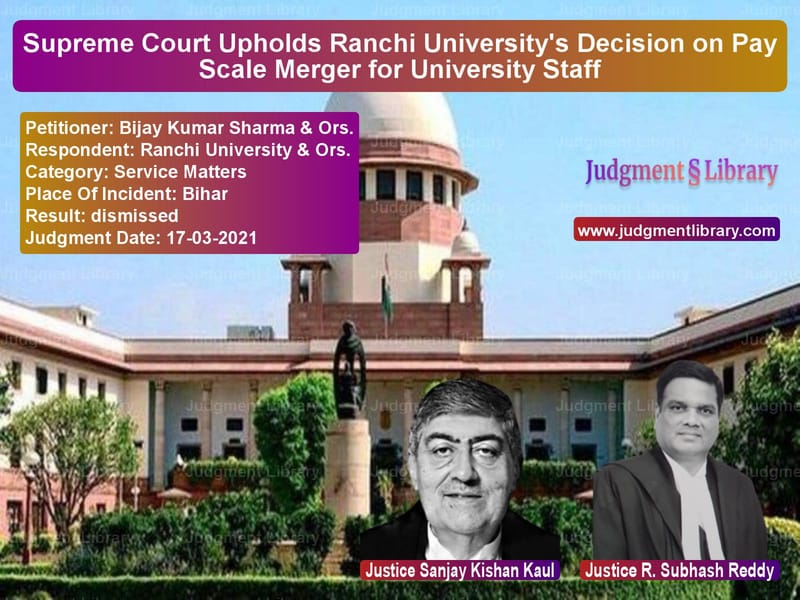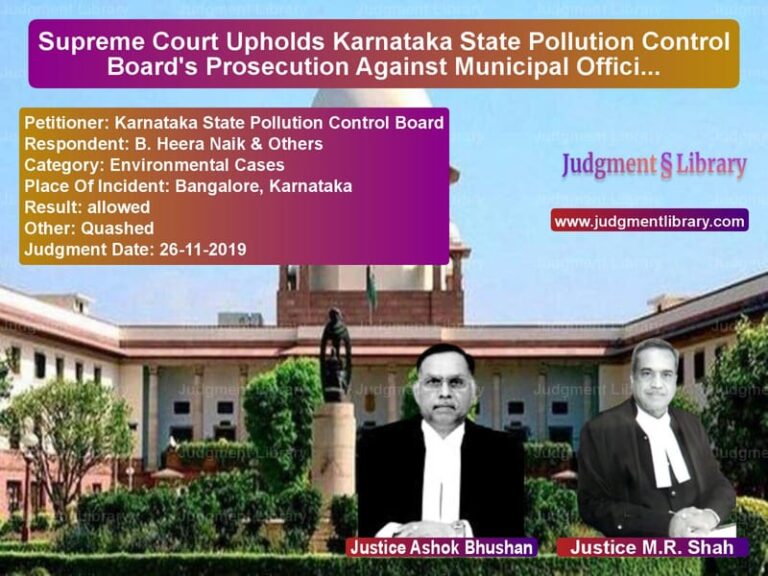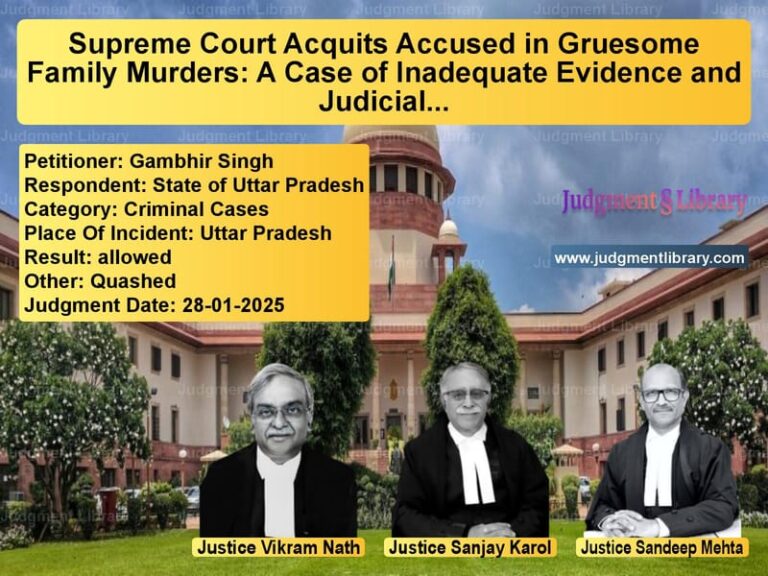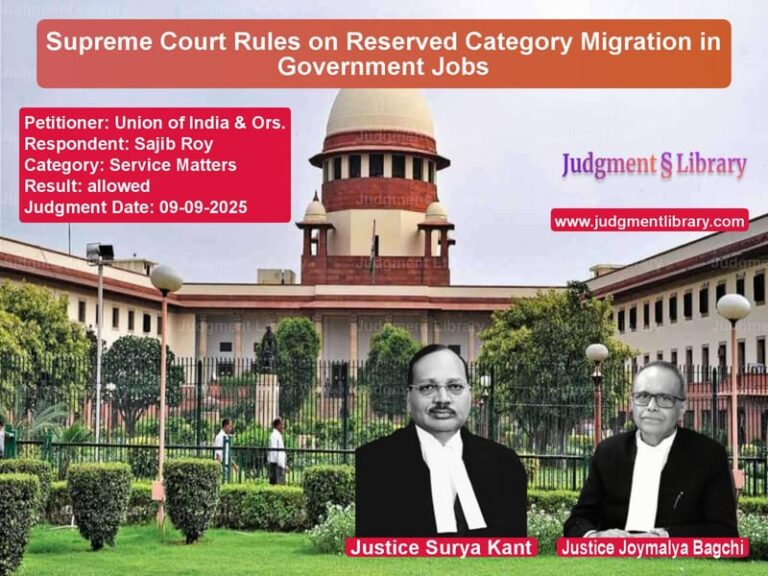Supreme Court Upholds Ranchi University’s Decision on Pay Scale Merger for University Staff
The case of Bijay Kumar Sharma & Ors. vs. Ranchi University & Ors. revolves around the dispute regarding the merger of pay scales for Lower Division Assistants (LDA) and Upper Division Assistants (UDA) in Ranchi University and other universities in Bihar. The Supreme Court was called upon to decide whether the petitioners, who were working in various clerical roles, were entitled to the same benefits as those granted to UDA and LDA staff in Patna University.
Background of the Case
The dispute dates back to 1998 when Ranchi University employees sought parity in pay scales with their counterparts in Patna University. The Bihar government had issued a letter on July 28, 1981, allowing a merger of pay scales for LDAs and UDAs in Patna University. However, the same benefit was not extended to other universities, leading to grievances among employees in Ranchi University.
Over the years, various communications and clarifications were issued by the government, but no uniform implementation occurred. The petitioners, who were working as clerks, typists, and storekeepers, argued that they were entitled to the same pay scale benefits as LDAs and UDAs in Patna University. The matter reached the Patna High Court, which initially ruled in favor of the petitioners. However, Ranchi University appealed the decision before a Division Bench, which overturned the ruling. The petitioners then approached the Supreme Court.
Key Issues Before the Supreme Court
The Supreme Court examined the following key questions:
- Whether the Bihar government’s pay scale merger order of 1981 applied to Ranchi University employees.
- Whether the university was justified in denying the pay scale benefits to the petitioners.
- Whether the Patna High Court’s Division Bench correctly overturned the Single Judge’s ruling in favor of the petitioners.
- Whether the petitioners were entitled to retain the financial benefits they had already received from 1990 to 1995.
Arguments by the Petitioners
The petitioners argued that:
- The government’s 1981 letter sanctioned the merger of pay scales for all universities, not just Patna University.
- Subsequent government communications, including a letter dated January 27, 1982, confirmed that the benefits extended to Patna University should also apply to other universities in Bihar.
- They had been granted the revised pay scales from 1990 to 1995, and revoking these benefits was unfair.
- The university’s decision to deny them the benefits was arbitrary and violated the principle of equal pay for equal work.
Arguments by Ranchi University
The university countered these arguments by stating:
- The 1981 letter applied only to Patna University, and no order was ever issued to extend the same benefits to other universities.
- The petitioners were not classified as LDAs or UDAs but were working in separate clerical and administrative roles.
- The university had the autonomy to set its own pay structure, and the state government’s pay revision orders were not automatically applicable.
- The Division Bench of the Patna High Court correctly ruled that the benefits granted to the petitioners from 1990 to 1995 were unauthorized.
Supreme Court’s Analysis
1. Scope of the 1981 Government Letter
The Supreme Court ruled that the July 28, 1981, letter did not grant a blanket pay scale merger for all universities. The letter specifically mentioned its application to Patna University, and the government had never explicitly extended it to other institutions. The Court observed:
Read also: https://judgmentlibrary.com/esi-act-interpretation-supreme-court-ruling-on-conveyance-allowance/
- “The letter merely clarified that the merger of pay scales was applicable where a higher and lower grade existed within the same category.”
- “The government’s later communications did not override this policy or extend it universally.”
2. Classification of Employees
The Supreme Court agreed with the university’s argument that the petitioners did not belong to the same category as LDAs or UDAs. The Court held:
- “The petitioners were working in different roles such as clerks, typists, and storekeepers, which did not have a structured lower and upper division system.”
- “The principle of equal pay for equal work applies only when there is parity in duties and responsibilities.”
3. Financial Benefits from 1990 to 1995
The Supreme Court acknowledged that the petitioners had received enhanced pay scales from 1990 to 1995. However, it ruled that the university was justified in revoking these benefits in 1995. At the same time, the Court held that the petitioners should not be required to return the money already received. The Court stated:
- “While the benefits were granted without proper authorization, the petitioners cannot be faulted for receiving them in good faith.”
- “The financial burden of recovering these amounts after so many years would be excessive and unfair.”
Final Judgment
The Supreme Court dismissed the appeal and ruled:
- The pay scale merger granted to Patna University employees did not automatically apply to Ranchi University.
- The petitioners were not entitled to the revised pay scales.
- The university was correct in revoking the benefits in 1995.
- The petitioners were not required to refund the financial benefits received from 1990 to 1995.
Implications of the Judgment
This ruling has significant implications for service matters and pay scale disputes:
- It reinforces the principle that government orders must be explicitly extended to apply to additional entities.
- It clarifies that pay scale mergers apply only to structured categories where lower and upper divisions exist.
- It upholds the university’s autonomy in setting pay scales.
- It provides relief to employees who have received unauthorized benefits in good faith by protecting them from repayment obligations.
The Supreme Court’s decision provides clarity on the limitations of government orders in pay scale matters and ensures that public institutions maintain financial discipline while treating employees fairly.
Petitioner Name: Bijay Kumar Sharma & Ors..Respondent Name: Ranchi University & Ors..Judgment By: Justice Sanjay Kishan Kaul, Justice R. Subhash Reddy.Place Of Incident: Bihar.Judgment Date: 17-03-2021.
Don’t miss out on the full details! Download the complete judgment in PDF format below and gain valuable insights instantly!
Download Judgment: bijay-kumar-sharma-&-vs-ranchi-university-&-supreme-court-of-india-judgment-dated-17-03-2021.pdf
Directly Download Judgment: Directly download this Judgment
See all petitions in Employment Disputes
See all petitions in Public Sector Employees
See all petitions in Pension and Gratuity
See all petitions in Judgment by Sanjay Kishan Kaul
See all petitions in Judgment by R. Subhash Reddy
See all petitions in dismissed
See all petitions in supreme court of India judgments March 2021
See all petitions in 2021 judgments
See all posts in Service Matters Category
See all allowed petitions in Service Matters Category
See all Dismissed petitions in Service Matters Category
See all partially allowed petitions in Service Matters Category







